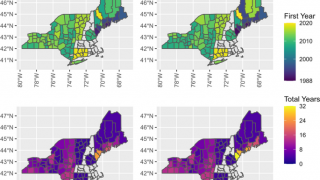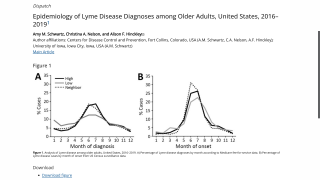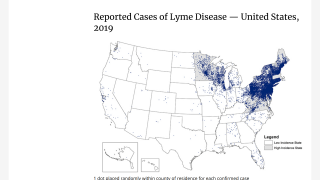Dogs Are Man’s Best Lyme Disease Alarm

A new study reconfirms dogs are the best ‘sentinels’ to assess a human’s risk for Lyme disease.
This study quantified the association between dog seroprevalence for the disease-causing bacterium, Borrelia burgdorferi, and human incidence of Lyme disease.
In this paper, Bayesian statistical methods were used to fit a spatiotemporal spline regression model to estimate the relationship between human Lyme disease incidence and canine seroprevalence.
A strong non-linear monotonically increasing association was found.
This means the analysis suggests that the mean incidence of Lyme disease in humans increases with canine seroprevalence until the seroprevalence in dogs reaches approximately 30 percent.
This is important, because Lyme disease is the most prevalent tick-borne disease in the USA, and there is not a commercially vaccine available today.
Furthermore, a recent study found 32 percent of tested ticks carried Lyme disease.
The risk was calculated as the proportion of dogs that test positive among all tested dogs within a county. The overall association shows that human Lyme disease incidence increases as dog seroprevalence increases.
Lyme disease is transmitted through the bite of a tick commonly known as the deer tick or black-legged tick.
Christopher Carpenter, executive director of Companion Animal Parasite Council (CAPC), said in a press release, “The model established in this research breaks new ground to give residents, travelers, and health care providers a county-level map to help them identify areas of risk across the country.”
The human risk for Lyme disease is not limited to Northeastern states. States that contain mostly high-incidence areas are Minnesota, Wisconsin, Maine, New Hampshire, Vermont, Massachusetts, New York, Connecticut, Rhode Island, New Jersey, Pennsylvania, Maryland, Delaware, and Virginia.
While other valid methods of estimating risk exist (field collection of ticks or human case reports), the study highlights the advantages of basing human pretest probabilities for Lyme disease on canine seroprevalence data, such as:
- Diagnosis of Lyme in humans can be challenging for a variety of reasons, one being the difficulty in determining a person’s epidemiologic risk when tick exposure is unknown.
- Dogs share an environment with humans, thereby providing evidence of peridomestic exposure risk.
- Canine seroprevalence data are reported monthly, at the county level, and on a national scale. Canine seroprevalence data provides a surveillance tool that is more robust against testing and reporting biases that are seen in human medicine. Canine data are less likely to exhibit reporting biases since test results are captured automatically and routinely.
- Obtaining widespread and contemporary Lyme disease data in humans is expensive and logistically challenging.
- In contrast to passive human Lyme disease surveillance, canine seroprevalence monitoring is active, with testing recommended for all dogs during annual wellness visits.
“By combining sophisticated statistical modeling with this invaluable canine data, we’re enabling veterinary medicine to benefit human medicine,” said Dr. Robert Lund, a professor in the Department of Mathematical Sciences at Clemson University.
“This research represents the first step on the long road to developing a forecast for human Lyme disease.”
With more than 27 million canine Borrelia burgdorferi antibody test results collected between 2012 and 2018 in dogs, these maps allow veterinarians, physicians, pet owners and travelers to assess the risk of exposure across the United States and Canada.
Lyme disease infections can be treated with an antibiotic, but if it is not treated it can lead to many problems, including muscle and joint aches, facial weakness, arthritis, and brain inflammation says the Centers for Disease Control and Prevention.
Recent Lyme disease news:
- Lyme Disease-Carrying Ticks Have Returned
- Asian Longhorned Ticks Are New And Spreading Fast
- Lyme Disease Vaccine Update in Washington DC
CAPC makes access to the monthly canine data available in its prevalence maps.
Formed in 2002, CAPC works to help veterinary professionals and pet owners develop the best practices in parasite management that protect pets from parasitic infections and reduce the risk of zoonotic parasite transmission
Results from the study were published in Geospatial Health.
Our Trust Standards: Medical Advisory Committee


























